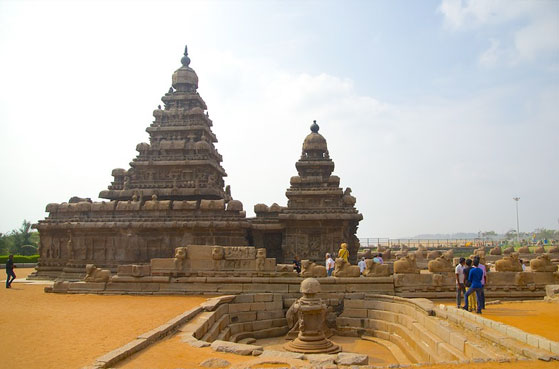 DEDICATED TO: Lord Vishnu and Lord Shiva
DEDICATED TO: Lord Vishnu and Lord Shiva
LOCATION: Tamil Nadu, Mahabalipuram
BUILD YEAR: Seventh Century
The majestic legacy of Indian heritage is explicitly showcased by this great standing temple, the “Shore Temple”, situated in one of the Southern states of the country, Tamil Nadu. This is one of the most loved and revered temples of India and looks magically beautiful particularly for, it is located on the shores of Bay of Bengal. Having been built in Seventh century this great monument of country India is full of the more than a little flavour of the Pallava dynasty. Historical evidences show that, while the Pallava art was at the pick of its popularity under the reign of Rajasimha. For the beauty and splendour of the temple, it has also been recognised and listed under UNESCO among one of the world heritage sites of India. Not only the serenity and the purity of the temple that attracts pilgrimage from across the world but the convenience with which it can be reached is also an important factor that makes it one of the favourite destinations for the devotees. You can reach the temple from anywhere in Tamil Nadu by taking locus buses or by taking taxis. Besides that, Mahabalipuram, the place where the temple is located is at a distance of 60 kms from the Chennai airport.
The temple is dedicated to worshipping both Lord Shiva and Lord Vishnu and has been built to have three shrines. The most significant of the three shrines has been dedicated to Lord Shiva and Lord Vishnu. There is a Shivalingam in the Grabhagriha which looks as if it is embracing the temple amiably and spreading its incredulous magnificence. At the back of the temple there’s these two shrines both of which faces each other and among both of these shrines one is dedicated to Lord Vishnu and other one manifests the grandeur of Ksatriyasimnesvara. Seshanag who has in Hindu religion been considered as the symbol of realization has been depicted with the image of Lord Vishnu. Lord Vishnu has been showcased recycling the Seshanag.
The peripheral walls of the shrine as well as the interior of the boundary walls which has been dedicated to Lord Vishnu has been ornately sculptured and carved. The sculptural and the artistic work on the walls of the temple gives an amazing and realistic feeling by manifesting few really heart-warming scenes from our everyday life. The lower part of the exterior walls has been impressed with a large number of lions. The shore temple in its essence is fundamentally a piece of art which was built as a result of the artistic insight of the Pallavas. The historical evidences show that pallavas were fanatically involved in artistic work and were keen to put in their aesthetic values in building temple with their own artistic style. The temple is also famous for showcasing the great dance traditional of Mahabalipuram and is organized in the month of January and February.
The temple for its gigantic tall structure on the shore of the sea appeared to the seafarers, as pagodas when they first saw it. The sailors named it as seven pagodas as this colossal structure standing on the seashore acted as a sight for navigating their ships. This beautiful temple is the result of the artistic work initiated in the 7th century by the Narasimha Varma I who was also known as Mammalla and after whom the city of Mamallapuram has been named. This architectural creation started with the monolithic Rathas and the cave temples. The styling and sophistication of the architecture of the temple has been credited to the King Rajasimha who rules during 700-28 AD and he was also called as Narasimhavarman II Pallava Empire.
In December 2004, the Tsunami that hit the coastline of Coromandel brought into light an ancient temple which was entirely collapsed and it was built wholly of granite blocks. A large many of speculations concluded that Mahabalipuram was one of the parts of the seven Pagodas which has special mention in the European diaries. Six of the seven Pagodas have been believed to have submerged into the sea. The Tsunami also brought into light a few of the ancient sculptures of elephants, lions and peacocks which were incorporated into the walls during the Pallava dynasty to enhance the beauty of the surrounding.
Shore temple is the first structure of stone that the rulers of the Pallava dynasty started working on. Unlike the many other monumental structures of the region, the shore temple is a rock-cut structure which is five storied. The Shore temple is one of the most significant and the earliest temples of the Southern States of India. Recently, in order to protect the temple from further getting eroded, stone walls have been built around the temple.
The pyramidal structure of the temple has been raised to a height of around 60 feet and has been suspended on a square plinth of 50 feet. The temple showcases a natural blend of history and richness of the artistic work of nature. The temple is so designed to catch the first rays of Sun and throw light on the waters after the Sunset.
6 AM to 6 PM
BEST TIME TO VISITIt’s advisable to visit the temple during Sunset and Sunrise as it adds to the charm of the temple. You can carry along a camera so that you can capture the scenic beauty of this temple. The sale of tickets of this temple closes at 5:30 PM.
ENTRY FEESFor Indian Citizen: Rs. 10
For Kids: Below 15 ears: Free Entry
Foreign national: US $ 5